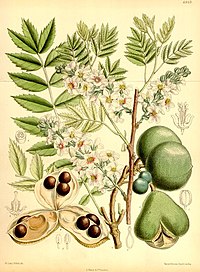
Isolation and Identification of some Primary Metabolites, Micro- and Macroelements of Aesculus hippocastanum L. Seeds
Sign Up to like & getrecommendations! Published in 2017 at "Phytopathology"
DOI: 10.25258/ijpapr.v9i1.8049
Abstract: The qualitative composition and quantitative content of amino acids were studied by PC and HPLC methods. 15 free amino acids were identified in the endosperm and skin of A. hippocastanum. 16 bound amino acids were… read more here.
Keywords: hippocastanum; seed; acids identified; amino acids ... See more keywords

Species Composition and Seasonal Abundance of Predatory Mites (Acari: Phytoseiidae) Inhabiting Aesculus hippocastanum (Sapindaceae)
Sign Up to like & getrecommendations! Published in 2023 at "Forests"
DOI: 10.3390/f14050942
Abstract: Species of the family Phytoseiidae (Acari: Mesostigmata) inhabit a wide range of herbs, shrubs, and trees. Horse chestnut, Aesculus hippocastanum, is an important ornamental tree in Europe and, in addition to its importance for pollinators,… read more here.
Keywords: species composition; abundance; predatory mites; aesculus hippocastanum ... See more keywords

Whey Proteins as a Potential Co-Surfactant with Aesculus hippocastanum L. as a Stabilizer in Nanoemulsions Derived from Hempseed Oil
Sign Up to like & getrecommendations! Published in 2021 at "Molecules"
DOI: 10.3390/molecules26195856
Abstract: The use of natural surfactants including plant extracts, plant hydrocolloids and proteins in nanoemulsion systems has received commercial interest due to demonstrated safety of use and potential health benefits of plant products. In this study,… read more here.
Keywords: aesculus hippocastanum; hempseed oil; whey proteins;

Bioactivity Potential of Aesculus hippocastanum L. Flower: Phytochemical Profile, Antiradical Capacity and Protective Effects on Human Plasma Components under Oxidative/Nitrative Stress In Vitro
Sign Up to like & getrecommendations! Published in 2021 at "Pharmaceuticals"
DOI: 10.3390/ph14121301
Abstract: Horse chestnut (Aesculus hippocastanum) flower is a traditional medicine applied to alleviate symptoms of chronic venous insufficiency (CVI). However, its flavonoid-based composition has not been sufficiently recognized, and the data supporting its traditional application are… read more here.
Keywords: hippocastanum flower; capacity; oxidative nitrative; human plasma ... See more keywords